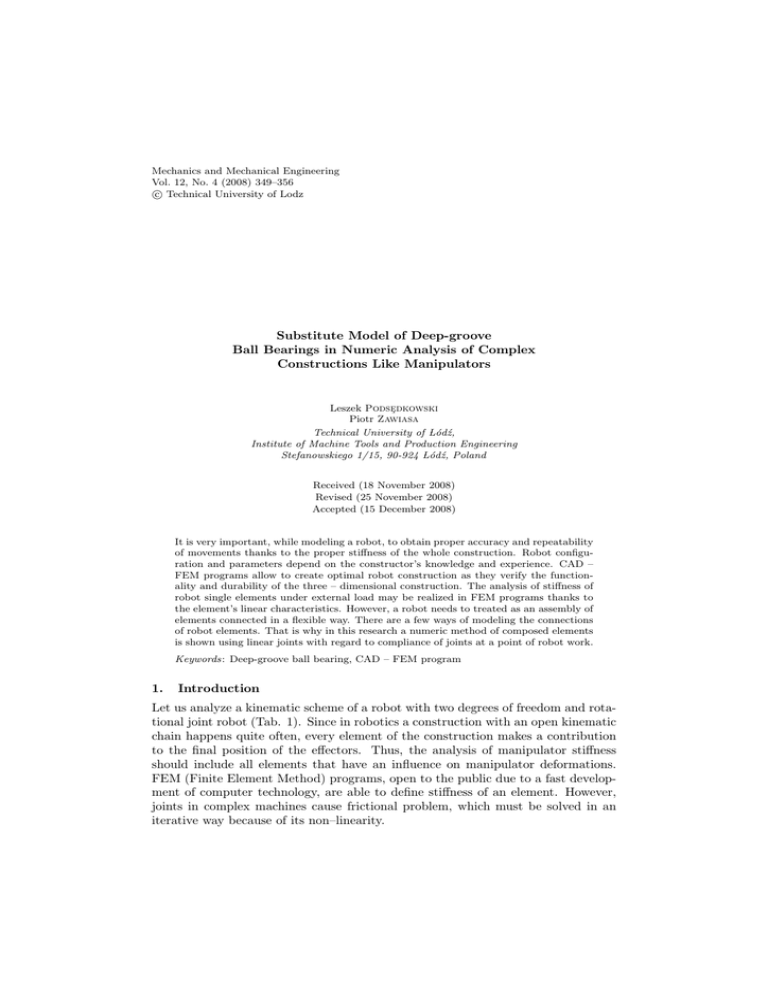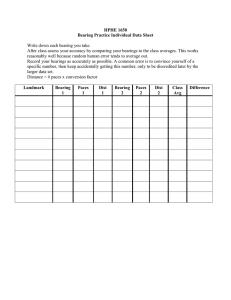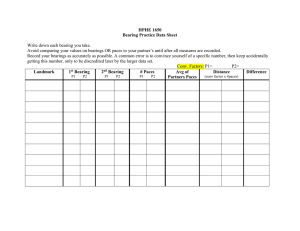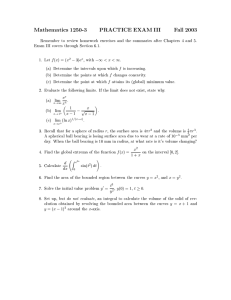Substitute Model of Deep-groove Ball Bearings in Numeric Analysis
advertisement

Mechanics and Mechanical Engineering Vol. 12, No. 4 (2008) 349–356 c Technical University of Lodz ° Substitute Model of Deep-groove Ball Bearings in Numeric Analysis of Complex Constructions Like Manipulators Leszek Podsȩdkowski Piotr Zawiasa Technical University of L Ã ódź, Institute of Machine Tools and Production Engineering Stefanowskiego 1/15, 90-924 L Ã ódź, Poland Received (18 November 2008) Revised (25 November 2008) Accepted (15 December 2008) It is very important, while modeling a robot, to obtain proper accuracy and repeatability of movements thanks to the proper stiffness of the whole construction. Robot configuration and parameters depend on the constructor’s knowledge and experience. CAD – FEM programs allow to create optimal robot construction as they verify the functionality and durability of the three – dimensional construction. The analysis of stiffness of robot single elements under external load may be realized in FEM programs thanks to the element’s linear characteristics. However, a robot needs to treated as an assembly of elements connected in a flexible way. There are a few ways of modeling the connections of robot elements. That is why in this research a numeric method of composed elements is shown using linear joints with regard to compliance of joints at a point of robot work. Keywords: Deep-groove ball bearing, CAD – FEM program 1. Introduction Let us analyze a kinematic scheme of a robot with two degrees of freedom and rotational joint robot (Tab. 1). Since in robotics a construction with an open kinematic chain happens quite often, every element of the construction makes a contribution to the final position of the effectors. Thus, the analysis of manipulator stiffness should include all elements that have an influence on manipulator deformations. FEM (Finite Element Method) programs, open to the public due to a fast development of computer technology, are able to define stiffness of an element. However, joints in complex machines cause frictional problem, which must be solved in an iterative way because of its non–linearity. 350 Podsȩdkowski, L. and Zawiasa, P. Figure 1 Influence of bearing flexibility on arms deformation Rolling bearings are commonly used because preload may be induced in them. Thanks to the preload, bearing slackness, which is inadmissible because of its ambiguous position while steering, is reduced. A mobile joint made by deep – groove ball bearings is a specific kind of a joint. These bearings, with radial and axial stiffness, are used in robot constructions because of their small size. To define the stiffness, a value of an contact angle of deep – groove ball bearing is necessary. It can be determined basing on Fig. 2. The angle of deep – groove ball bearings that takes into account the radial clearance may be determined by the following equation according to [1] : µ ¶ Pd αo = arccos 1 − (1) 2A A = rb.zew + rb.wew − 2rk Pd – radial clearance of a bearing It can be proved that in deep- groove ball bearings the contact angle is considerably variable. For example, in 6202 bearing for radial clearance that is contained in norms [2] for the particular values of the ball race radius rb.zew = rb.wew = 1, 04 rk, the angle changes by seven degrees between the lowest and the highest value of clearance. According to[3], it is possible to determine the stiffness of rolling bearings in axial and radial directions. Due to a fact that manipulators are complex, special and open, the analysis of deformations with the friction taken into account is quite difficult. After introducing preload into bearing system, system linearity is obtained. A model of a bearing with linear characteristics and stiffness that corresponds to bearing work was proposed. Few three – dimensional models showing a deep – groove ball bearing were created. Its final version is shown in Fig. 4. Substitute Model of Deep-groove Ball Bearings ... 351 Figure 2 Dependence of the contact angle of deep - groove ball bearing on radial clearance Figure 3 The influence of radial clearance on the contact angle 2. Mathematical model Following assumptions were taken for calculations: • The outer dimensions correspond to dimensions of the bearing • The model consists of one part with two outer rings which are connected with each other by beams • Young’s modulus ’E’ is a constant value of bearing steel • Data that model the stiffness are following dimensions of a beam: h – height, b - width, l – length and the number of beams in a model, are 352 Podsȩdkowski, L. and Zawiasa, P. Figure 4 Model 3D bearings It may be written EI d2 y = −P (l − x) + M u dx where: E – Young’s modulus I – inertia modulus Mu – fixing moment fM g(x=l) = P l3 12EI (2) (3) Figure 5 Digitizing of a bearing model This equation for beam deformation takes into account only bending force. This deformation illustrates the deflection for beams with high proportion of length and height. In the analyzed case the proportion is close to one. Therefore, shearing forces need to be taken into account. According to [4] , total deformation of the beam is: f (x) = fM g(x) + fT (x) (4) Substitute Model of Deep-groove Ball Bearings ... where: fM g(x) – deflection caused by bending moment fT (x) – deflection caused by shearing moment Therefore: dM g(x) T(x) = dx The differential equation of fT (x) function is: f ”(x) = dT (x) k dx GA 353 (5) (6) where : k – dimensionless coefficient depending on the shape of rectangular section k = 1.2 [4] G – shear modulus of elasticity A – section exposed to shearing Figure 6 Scheme of radial force distribution in a model After double integrating, an equation for maximal deformation as a consequence of shearing force is obtained: P kl (7) f(x) = GA After taking into consideration that G= E 2(1 + ν) (8) and that section of the sheared beam is rectangular (its coefficient of section shape k = 1.2; section inertia modulus I = bh3 /12 and Poisson’s ratio ν = 0.3) µ ¶2 h P l3 3.12 (9) f(x) = Ebth3 l 354 Podsȩdkowski, L. and Zawiasa, P. the total deformation of the beam is g f(x=l) " µ ¶2 # P l3 h = 1 + 3, 12 Ebh3 l (10) Radial force Pr acting on the bearing model may be expressed: X Pr = Pr (i) i 3 X X bh bh = wr E h sin2 (α(i)) + cos2 (α(i)) (11) ¡ ¢2 i i i l l3 1 + 3, 12 hl Axial force Po acting on the bearing, decomposes uniformly on all beams (Fig. 7). Therefore: hb l3 hb3 h i+ (12) Po = Zwo E Ebh3 l3 1 + 3, 12 ¡ b ¢2 l l where: Z – the number of beams in a model wo – displacement of the bearing Figure 7 Scheme of axial force loading of the bearing model Basing on equations (8)(9) parameters of a beam ’b’ and ’h’ were determined and program Model 3D in Visual Basic cooperating with program CAD was created. It uses methods of calculating the stiffness of bearings according to [3] and generates 3D solid that models the bearing of a given axial and radial stiffness. Substitute Model of Deep-groove Ball Bearings ... 3. 355 Results of calculations To compare the influence of the way of modelling the deep – groove ball bearings on deformations, following solid models used in robot construction were used: 1. ring – shaped model with outer dimensions corresponding to bearing dimensions 2. model taken from the internet data base [5] consisting of outer and inner rings and nodules; rb.zew = rb.wew = rk . 3. analytical model 4. model generated with Model 3D program of a given stiffness. An example of a shaft ( Fig. 8) supported on two identical deep – groove ball bearings, which is loaded with forces Fx = 200 N and Fy = 1000 N applied on the arm R = 100 mm was analyzed. Figure 8 Scheme of loading of bearing system Analyzing the bearing system with preload, it may be stated that the system characteristics is quasi – linear [3]. That is why, joints between elements leading to linear solution may be used in numeric calculations. The contact angle was obtained by 356 Podsȩdkowski, L. and Zawiasa, P. formula 1, assuming that axial clearance in 6202 bearing was Pe = 0, 06 mm, the diameter of a nodule rk = 6 mm and the race radius rb.zew = rb.wew = 1, 04rk . Results of deformations are shown in tablet (1) Table 1 Influence of bearing flexibility on arms deformation. Deformations in X axis [mm] Deformations in Y axis [mm] Model 1 0,018 Model 2 0,019 Model 3 0,047 Model 4 0,053 Fixed beam 0,004 0,005 0,013 0,016 0,008 0,022 It is seen that while modeling a shaft being supported by bearings with models 1 and 2, the stiffness of a node is very high and actually takes into account the deformation of the beam itself as if it were fixed. When model 4 was used, the whole bearing node was deflected. Model 4, in contrast to model 3, takes into consideration overturning moments of the bearing. Therefore, there are differences of deflections between the models. 4. Conclusions Thanks to the usage of numerical methods and the Model 3D program in analyzing the deformations of manipulators it became very easy to quickly generate the models of deep – groove ball bearings of given stiffness and to analyze the influence of this stiffness on the deformations of a whole construction. According to the numerical calculations shown in the tablet, modelling of a bearing is of a great importance as it considerably influences the deformations of a whole construction. References [1] [2] [3] [4] [5] Harris, T.A.: Rolling bearing analysis, New York: John Wiley & Sons, 1966. Norma PN – ISO 5753: L Ã ożyska toczne – Luz promieniowy 1996. Krzemiński–Freda, H.: L Ã ożyska toczne, Warszawa, PWN, 1989. Gawȩcki, A. Mechanika materiaÃlów i konstrukcji prȩtowych. Poznań: WPP, 1988. http://www.tracepartsonline.net/. [Online]


